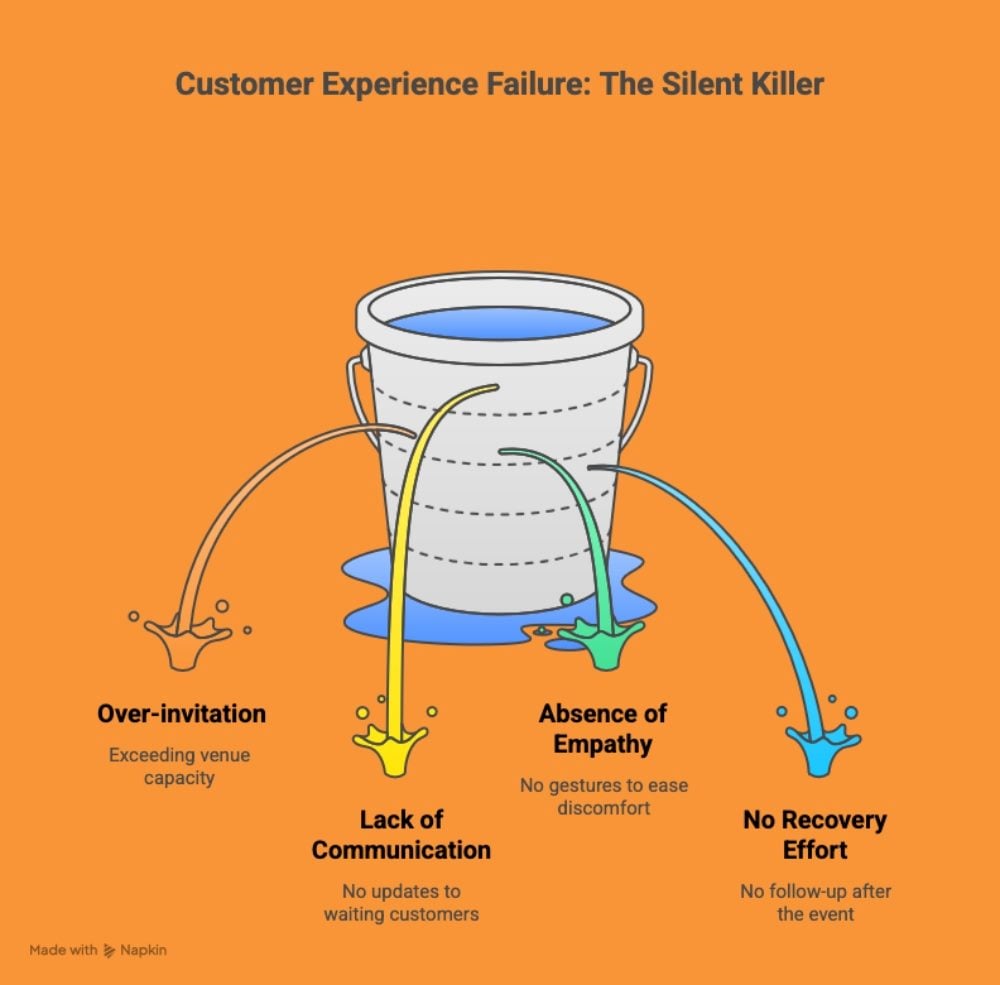The Gist
- Silence erodes trust. When something goes wrong, failing to communicate sends a louder message than the mistake itself — it tells customers they don’t matter.
- Empathy builds loyalty. Simple gestures like updates, water or acknowledgment can transform frustration into understanding and reinforce brand respect.
- Communication is the bridge. The best companies use honest, real-time communication to close the gap between expectation and experience — especially when plans fall apart.
A few weeks ago, I was invited to an event as a preferred customer. The invitation made it sound exclusive—limited seating, personalized experiences and the kind of attention that makes loyal customers feel valued. I registered well in advance and looked forward to the event.
When I arrived, however, the scene was very different from what any of us expected. The venue, which could only hold about 500 people, had a line of well over 1,000 attendees snaking around the building. The line barely moved for nearly an hour. It was hot, people were frustrated, and many of those waiting were over 65 years old—standing on concrete for that long took a real physical toll.
Eventually, we were let in. The event began almost an hour late, with no apology, no explanation and no acknowledgment of what had gone wrong. Instead of feeling like VIPs, we felt ignored.
And that’s where the real failure occurred—not in the logistics, not in the overcrowding, but in the absence of communication.
Table of Contents
- The Silent Killer of Customer Experience
- The Emotional Impact of Poor Communication
- Where Things Went Wrong
- What Great Companies Do Differently
- Turning Missteps into Moments of Loyalty
The Silent Killer of Customer Experience
In customer experience, silence is rarely golden. When something goes wrong—and it will—what customers remember most is how the company responds. A poor situation can become a loyalty-building moment if handled with empathy, transparency and proactive communication. But in this case, the silence spoke volumes.
In an age where customers expect real-time updates from airlines, delivery services and restaurants, a lack of information feels like disrespect. It says, “Your time doesn’t matter.” Worse, it suggests that the company either doesn’t know what’s happening or doesn’t care enough to tell you.
The event organizers may have been overwhelmed. They may have been scrambling behind the scenes to accommodate the overflow. But for those waiting outside, the optics told a different story: chaos, disorganization and disregard.
Related Article: OpenAI Forgot the Golden Rule of CX: Don't Yank Away What Customers Love
The Emotional Impact of Poor Communication
Customer experience isn’t just about what people see—it’s about how they feel.
Imagine being 65 years old, standing for over an hour with no water, no updates and no staff presence. You’re unsure if you’ll even get in. You start to feel frustrated, disrespected and maybe even regretful for supporting a brand that doesn’t seem to value your comfort.
The irony is that these were the company’s best customers—the loyal ones who show up early, register on time and spread word-of-mouth praise. They deserved better, and not just because they had spent money with the brand. They deserved better because communication is one of the simplest, most powerful acts of respect in customer experience.
Related Article: The Loyalty Equation: Trust + Context + Community
Where Things Went Wrong
Let’s break it down:
- Over-invitation without capacity planning – If the venue holds 500, inviting more than that without a contingency plan sets up failure.
- Lack of real-time communication – No emails, texts, signage or staff updates left customers confused and anxious.
- No empathy in the moment – Simple actions—passing out water, offering seating for seniors or even acknowledging the delay—could have softened frustration.
- No recovery effort afterward – Post-event follow-up could have turned this from a negative story into a redemptive one, but none came.
Each of these points reflects a breakdown in communication, both operationally and emotionally.

What Great Companies Do Differently
Top-performing organizations understand that communication is the bridge between expectation and experience. When something doesn’t go as planned, they move quickly to close the gap between what customers expected and what they’re experiencing.
Here are a few best practices every company can apply:
Customer Experience Breakdown
This table outlines how a “preferred customer” event went wrong—highlighting communication breakdowns, customer reactions, and how each failure could have been turned into a moment of trust and loyalty.
| Failure Point | Customer Impact | Better Approach |
|---|---|---|
| Over-invitation beyond venue capacity | Guests arrived to find overcrowding and long wait times, leading to frustration and physical discomfort. | Plan invitations according to venue limits and prepare overflow or streaming options to accommodate demand. |
| Lack of real-time updates | Customers stood outside for nearly an hour with no communication, feeling ignored and undervalued. | Send timely alerts via text or email, post signage or deploy staff to explain the delay and manage expectations. |
| No empathy during the wait | Attendees—many older adults—were left without water, shade, or seating, creating emotional and physical strain. | Offer small gestures like water bottles, fans and chairs for seniors to show awareness and care in the moment. |
| Silence from event organizers | Customers perceived disorganization and indifference, eroding brand trust and loyalty. | Begin the event with an acknowledgment or apology, showing transparency and gratitude for guests’ patience. |
| No post-event communication | Attendees left without closure, increasing negative word-of-mouth and lasting disappointment. | Follow up with a thank-you email, a sincere apology, and perhaps a small goodwill gesture to rebuild goodwill. |
| Overall communication failure | The experience shifted from “exclusive” to “chaotic,” damaging the brand’s reputation among its most loyal customers. | Make proactive, empathetic communication a CX standard—before, during and after every customer interaction. |
Turning Missteps into Moments of Loyalty
In customer experience, perfection is impossible—but authenticity is not. The most admired brands are not the ones that never stumble; they’re the ones that handle missteps with humility, empathy and swift communication.
In my case, a simple acknowledgment at the door, an email before arrival, or even an apology at the start would have completely changed the tone of the day. Instead of feeling dismissed, I would’ve felt seen.
And that’s the ultimate takeaway for any business: when things go wrong, your words matter as much as your actions. Communicate clearly, consistently and compassionately—and you might just turn a frustrated customer into an even more loyal one.
Learn how you can join our contributor community.
